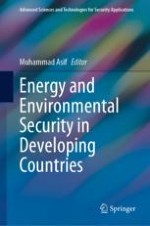Abstract
Southeast Asia (SEA) is composed of Brunei, Myanmar, Cambodia, Timor-Leste, Indonesia, Laos, Malaysia, the Philippines, Singapore, Thailand and Vietnam. The population is forecasted to expand by 20% with the urban population alone growing by over 150 million people which is the driving force behind the region’s growing energy demand. The Association of Southeast Asian Nations (ASEAN) and six other countries in the Asia–Pacific region comprising of: Australia, the People’s Republic of China, India, Japan, Korea and New Zealand forming the ASEAN + 6 group, whose share of global energy demand is expected to reach 40% by 2040 making this region the world’s most dynamic economically. Southeast Asia’s supply of energy comes from more than 50% of fossil fuels (led by oil, coal and natural gas) and 17% from renewables but the supply is now depleting fast as these countries have become net importers of oil rather than exporters since 2018. The region is also relatively well endowed with renewable energy sources particularly in hydro and solar and other types of renewable energy (such as geothermal found mainly in the Philippines and Indonesia). Although this region has set out a target to contribute 23% of its primary energy supply from renewables by 2025, conventional fossil energy still dominates the regional energy mix. Energy security has now become an issue as it affects Southeast Asia’s efforts to secure their energy requirements in a sustainable manner environmentally and economically. Continuous reliance on energy imports, especially of oil and gas, to sustain economic growth serves as an example of Asia’s energy insecurity. Natural gas security has also become a concern in the region, as it is expected to account for 85% of the growth in global gas trade between now and 2040. The energy impacts on environmental systems and climate change have strong links to energy security. More than 60% of global carbon dioxide emissions are produced from energy supply and transport. Continuing to subsidise the cost of energy to citizens over the course of the next ten years will not be sustainable. It becomes necessary to reform some present policies and formulate new policies to ensure the energy security of these countries. Governments in the region also need to employ alternative energy sources and collaborate to maintain energy security not only for their own countries, but for the rest of the region as well. Recent reports by the World Economic Forum (WEF) have favorably focused on ASEAN countries based on their current energy systems and readiness to adapt to future needs. This chapter therefore, discusses on the current scenario of energy in the light of climate change, sustainability in environment, energy security issues and economy in ASEAN + 6, barriers, possible solutions, and case studies of mitigation efforts as well as policies laid out and implemented with specific examples from Malaysia, Thailand, Indonesia, Singapore, Vietnam and the Philippines.
